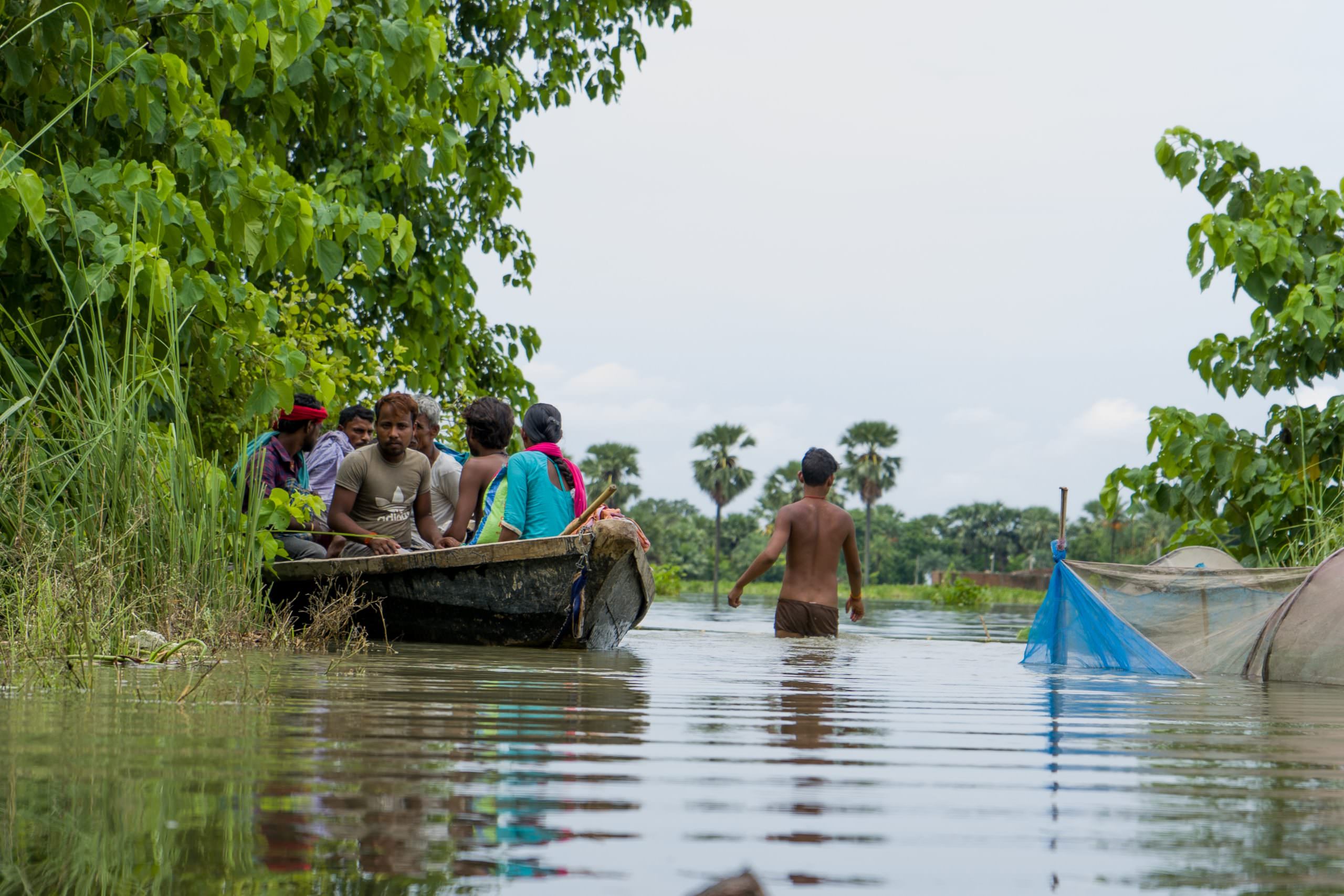
Climate change can lead to extreme weather. People in Bihar, India stranded in a flood.
Anthony Acciavatti works at the intersection of architecture and the history of science and technology. His most-recent book, Ganges Water Machine: Designing New India’s Ancient River, is the first comprehensive mapping and environmental history of the Ganges River Basin in over half a century. He will join a panel at this year’s Mittal Institute Annual Symposium focused on climate change in South Asia on May 18 with Harvard professors Sheila Jasanoff and Michael McElroy, as well as the University’s Vice Provost for Climate and Sustainability, James H. Stock.
Mittal Institute: Professor Acciavatti, we’re really looking forward to your panel on climate change and learning more about your extensive research on the Ganges and your book, Ganges Water Machine: Designing New India’s Ancient River. What are some of the most interesting aspects of the Ganges and its environmental history that you would like people to know?
Anthony Acciavatti: I think one of the most compelling aspects of the Ganga River basin is its soils. Ever since the subcontinent collided with Asia 50 million years ago, trillions upon trillions of tons of silt and sediment have been shed from the ever-growing Himalayas during the tempestuous firewater cocktail that we call the monsoons. This silt and sediment are what makes the basin’s soils rich for agriculture and for irrigation. These soils act like sponges and retain water in the ground. Millions of farmers rely on mechanized wells, known as tubewells, to draw up this groundwater for irrigation. Indeed, millions of urban dwellers rely on tubewells for potable water. In short, the soils of the Gangetic plains create unique urban-agrarian linkages across the basin and much of India.

Anthony Acciavatti, Daniel Rose (1951) Visiting Assistant Professor, Yale University.
Today India is the largest consumer of groundwater in the world. And a great deal of groundwater extraction is drawn from the soils of the Ganga River basin. Unfortunately, despite the ubiquity of groundwater, it is unevenly accessed due to economic constraints and increasingly extracted faster than it is replenished with the monsoons.
Today India is the largest consumer of groundwater in the world. And a great deal of groundwater extraction is drawn from the soils of the Ganga River basin.
Mittal Institute: The book focuses a lot on water and the many conflicts over water for drinking, agriculture, and industry. Could you talk more about this and how climate change is impacting the situation in South Asia?
Anthony Acciavatti: Ecologists often look through the lens of “indicator species” to measure and explain environmental change. By focusing on, say, sparrows, an ecologist can learn a great deal about all the other constituents that make up the habitats of sparrows. For me, water is an equally potent lens to measure and draw social and political changes together with environmental conditions. Drawing the ways in which surface water bodies, like lakes and rivers, overlap with sub-surface water bodies, like aquifers, can tell us a great deal about the ways in which biophysical processes like rainfall and groundwater recharge interface with urban growth and agricultural production. Climate change poses serious threats to rainfall patterns across much of South Asia. We can expect greater swings between too much water and too little water.
Mittal Institute: Your decade-long research for the book sounds both fascinating and a lot of fun–hiking, driving and boating across the Ganges to map it. Any favorite moments you’d like to share with our audience?
Anthony Acciavatti: I think some of my favorite time throughout my work was making my own instruments to measure the choreography of soils across the basin. Because between 1 and 1.6 billion tons of sediment and silt are shed every year from the Himalayas during the monsoons, knowing more about the distribution and transportation of soils can tell a lot about river channels and inhabitation.
Because the basin had not been mapped in half a century, I had no choice but to develop guerilla tactics to measure the choreography of soils through devices like the surface accumulation sleeve, a prosthetic worn over the right arm to map soils. It is equipped with a GPS unit as well as rolls of packaging tape so that, just as Spiderman shoots his web from his wrist, I shoot packaging tape from my arm to collect soils.
Because the basin had not been mapped in half a century, I had no choice but to develop guerilla tactics to measure the choreography of soils through devices like the surface accumulation sleeve, a prosthetic worn over the right arm to map soils. It is equipped with a GPS unit as well as rolls of packaging tape so that, just as Spiderman shoots his web from his wrist, I shoot packaging tape from my arm to collect soils. I do this for at least one kilometer perpendicular to the river edge so that I collect as many different soil types as possible. My strands of tape collect soils, but also flowers, plastics, auto parts and more. These artifacts from human and non-human occupation allow me to conduct an ethnography of the soil. I used this instrument several hundred times to conduct these ethnographic studies of the soil.

The Surface Accumulation Sleeve.
The imprint that the packaging tape leaves on the ground.
Mittal Institute: We’re looking forward to your next book, Republic of Villages, which looks at the histories of science and environmental design in South Asia since the late-nineteenth century. Could you tell us more about some of the key themes?
Anthony Acciavatti: At its heart, Republic of Villages asks how to think about dreams of social engineering and design pedagogy in the service of nation building in the19th and 20th centuries. In particular, the book focuses on how a group of scientists and engineers collaborated with architects and artists to develop new forms of visual pedagogy in South Asia. The goal of this pedagogy was to provide the local community with tools and resources to build new communities and industries from the village level. Rooted in the material culture of these practices, the book retrieves the ways in which design and the sciences were crucial components of colonial and postcolonial development schemes in the region and beyond. Throughout each of the chapters, I show how visual pedagogy developed–not in spite of regional differences and ecological concerns, but because of them.




